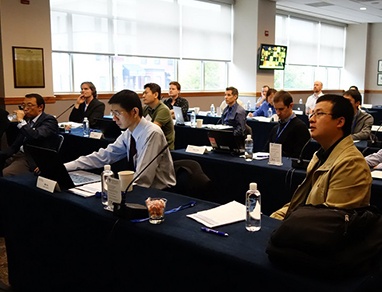Adaptive Structured Illumination Incubator
Adaptive Structured Illumination Incubator
Marcia Lesky

- What are the barriers for super-resolution at depth?
- What are the fundamental limits in fibre imaging (resolution, correction, speed)?
- What are the challenges of using structured illumination for in vivo imaging?
These are just a few of the questions that were explored at last week’s Adaptive Structured Illumination Incubator. Hosted by Meng Cui from Purdue University, US, and Kishan Dholakia and Michael Mazilu from the University of St. Andrews, UK, this Incubator used invited talks and moderated group discussion to allow experts to cross-fertilize ideas in applications of structured illumination throughout photonics.
The idea of patterning or structuring light fields is now embedded into many areas of photonics in the form of control of light in amplitude, phase, polarization and spectral dispersion. This Incubator explored this theme in five key areas:
- Functional Imaging at Depth
- Reducing the Photon Budget
- Transmission through Complex Media
- Fundamentals of Orthogonality and Information Transfer
- Structured Illumination
As host Dr. Dholakia said: Light is amazing. It allows us an unprecedented view of the biological world in all its rich detail. However we all know light can’t penetrate very far when encountering a scattering or distorting object… think about how your bathroom window scrambles light obscuring the view outside. With this incubator, we aimed to look at ways to tailor the properties of light to improve the way it can propagate into biological media and beyond yet retain good resolving power to ensure we can see the intricate detail of the biological systems even at great dept. The merging advances in photonics could revolutionize the way we visualize disease and develop tools to understand biomedical problems particularly in neuroscience and beyond.
The meeting began with an exploration of functional imaging at depth. As the panelists discussed, while optical imaging has shown some startling results, there is a need to move towards functional imaging, so we may detect or measure changes in blood flow, local chemical composition, absorption and metabolic function.
The meeting then explored the one of the main challenges in modern photonics – the transmission of light and imaging through highly scattering media or multimode devices. Although there are advances in this field promises to achieve minimally invasive medical diagnostics, a number of key challenges need to be overcome for these techniques to be useful in bio-photonics. This includes how to focus and scan light at will anywhere within a sample. This topic discussed these challenges, their potential solutions and future applications of these techniques.
From there the participants explored the challenges of using structured illumination for in vivo imaging, the role of orthogonality in imaging and information transfer and how to reduce the photon budget for imaging. Such concepts mean we ideally might obtain maximal information with the lowest possible irradiation – thus avoiding any damage. This would be ideal for in vivo studies and long term live imaging of a myriad of biological systems. Interesting comparisons between super-resolving approaches made for a lively debate and discussion. Certainly choosing your imaging approach for a given biomedical problem pays dividends!
Excitingly a number of new links and emerging themes were identified. There is little doubt of the importance of these emerging areas that are truly setting the agenda for visualizing the biomedical world. The hosts plan to continue the discussion and will be working with OSA on the potential next steps - so stay tuned to hear more on Adaptive Structured Illumination!
